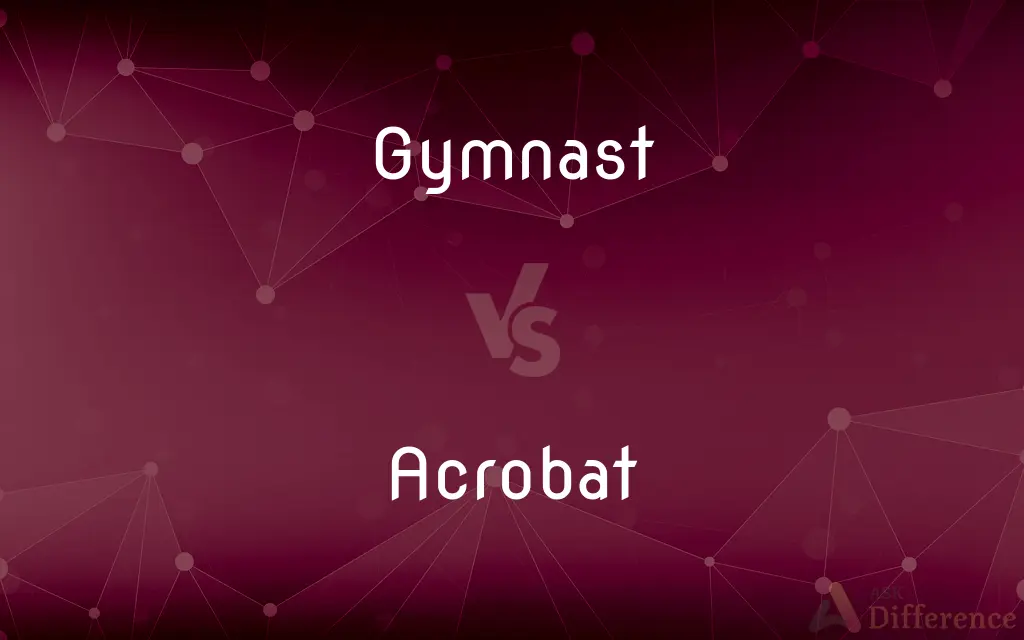Gymnast vs. Acrobat — What's the Difference?
By Urooj Arif & Maham Liaqat — Updated on April 1, 2024
A gymnast specializes in gymnastics, focusing on strength, flexibility, and coordination within a competitive or exhibition framework, while an acrobat performs acrobatic feats, often in circuses or entertainment settings, emphasizing agility and balance.

Difference Between Gymnast and Acrobat
Table of Contents
ADVERTISEMENT
Key Differences
Gymnasts are athletes who train in the sport of gymnastics, which includes disciplines like artistic gymnastics, rhythmic gymnastics, and trampoline. This sport requires rigorous training, focusing on precise movements, routines, and often involves competing at various levels, from local to the Olympics. Acrobats, on the other hand, are performers known for their ability to execute daring physical acts that involve tumbling, flipping, and balancing, often as part of a circus, variety show, or theatrical performance, where the emphasis is on entertainment rather than competition.
While gymnasts follow a strict set of rules and scoring systems in competitions, acrobats perform to captivate and engage an audience, with less emphasis on scoring and more on the aesthetic and thrilling aspects of their acts. Gymnastics is recognized as an Olympic sport with structured training programs and competitive pathways, whereas acrobatics is more varied in its practice and often intersects with other performing arts.
Gymnasts use specific apparatuses like bars, beams, and vaults in their routines, which are integral to their sport's disciplines. Acrobats may use equipment such as trapezes, tightropes, or simply perform on the ground, and their routines are more flexible, adapting to the theme or story of the performance.
The training for gymnasts is highly specialized, focusing on perfecting techniques and routines for competition. Acrobat training, while also rigorous, is more diverse, incorporating elements from dance, gymnastics, and sometimes aerial skills, to create visually stunning performances. Both gymnasts and acrobats require a high level of physical fitness, but their goals differ: gymnasts aim to achieve excellence in their sport, while acrobats seek to entertain and amaze audiences.
Comparison Chart
Focus
Competitive sport focusing on strength, flexibility, and coordination.
Performance art focusing on agility, balance, and daring feats.
ADVERTISEMENT
Setting
Competitions (local to Olympic levels).
Circuses, variety shows, theatrical performances.
Rules/Scoring
Follows strict rules and scoring systems.
Emphasis on audience engagement and entertainment value.
Apparatus/Equipment
Uses apparatuses like bars, beams, vaults.
May use trapezes, tightropes, or perform on ground.
Training
Specialized training for technique perfection and routine execution.
Diverse training incorporating dance, gymnastics, and aerial skills.
Compare with Definitions
Gymnast
An athlete who competes in gymnastics, emphasizing precise movements and routines.
The gymnast won a gold medal for her flawless floor routine.
Acrobat
A performer engaging in daring physical acts for entertainment.
The street acrobat gathered a crowd with his incredible juggling and flips.
Gymnast
A competitor in gymnastic sports, aiming for excellence and high scores.
The Olympic gymnast trained for years to perfect his vault performance.
Acrobat
An individual skilled in agility and physical coordination, often part of a circus.
Acrobats in the circus executed a flawless high-wire act.
Gymnast
A practitioner of gymnastics, training in disciplines like artistic or rhythmic gymnastics.
As a young gymnast, she excelled in the balance beam.
Acrobat
A person specializing in acrobatics, incorporating elements of dance and gymnastics.
The acrobat’s routine blended gymnastic precision with dance-like grace.
Gymnast
An individual dedicated to gymnastics, often competing at various levels.
She admired the gymnast’s dedication to mastering complex routines.
Acrobat
A performer known for executing acrobatic feats, such as tumbling and balancing.
The acrobat amazed the audience with her aerial silk performance.
Gymnast
A participant in gymnastics, focusing on strength, flexibility, and coordination.
The collegiate gymnast balanced academics with rigorous training.
Acrobat
An artist in the performing arts, thrilling audiences with physical feats.
The show’s lead acrobat performed breathtaking stunts above the stage.
Gymnast
A person who is trained and skilled in gymnastics, especially one who engages in competition.
Acrobat
One who is skilled in feats of balance and agility in gymnastics.
Gymnast
One who performs (the sport of) gymnastics.
Acrobat
One who changes one's viewpoint on short notice in response to the circumstances.
Gymnast
One who teaches or practices gymnastic exercises; the manager of a gymnasium; an athlete.
Acrobat
An athlete who performs acts requiring skill, agility and coordination, often as part of a circus performance.
Gymnast
An athlete who is skilled in gymnastics
Acrobat
To practise acrobatics.
Acrobat
(figurative) To move like an acrobat (with agility, balance, long leaps, etc.).
Acrobat
One who practices rope dancing, high vaulting, or other daring gymnastic feats.
Acrobat
An athlete who performs acts requiring skill and agility and coordination
Common Curiosities
How do acrobats contribute to a performance?
Acrobats contribute by adding elements of thrill, agility, and visual spectacle to a performance, often engaging the audience with daring and aesthetic physical acts.
What distinguishes a gymnast's training from an acrobat's?
A gymnast's training is highly specialized, focusing on perfecting techniques and routines for competitions, while an acrobat's training is more diverse, incorporating elements of dance, gymnastics, and aerial skills for entertainment.
How is success measured in gymnastics versus acrobatics?
In gymnastics, success is measured by scores awarded for technique, difficulty, and execution in competitions, while in acrobatics, success is often gauged by audience response and engagement.
Can gymnasts perform acrobatic feats?
Yes, gymnasts often perform acrobatic feats within their routines, especially in disciplines like floor exercise, but these are structured around the sport's competitive rules.
What makes gymnastics a competitive sport?
Gymnastics is considered a competitive sport due to its structured rules, scoring systems, and organized competitions ranging from amateur to the Olympic level.
Why might someone choose to pursue acrobatics?
Individuals might choose acrobatics for the love of performance, the thrill of executing daring feats, and the desire to entertain and captivate audiences.
How does the audience's role differ in gymnastics and acrobatics?
In gymnastics, the audience appreciates the technical skill and precision, while in acrobatics, the audience is more directly engaged, often seeking entertainment and visual spectacle.
Are acrobatics and gymnastics the same?
While acrobatics and gymnastics share similarities in physicality and skill, they differ in their objectives; gymnastics is a competitive sport, whereas acrobatics is primarily performance art.
Can someone be both a gymnast and an acrobat?
Yes, individuals can possess skills in both areas, with gymnasts transitioning to acrobatic performances and vice versa, leveraging their agility, strength, and balance.
What are the key skills for a gymnast?
Key skills for a gymnast include strength, flexibility, coordination, precision in movements, and the ability to perform complex routines on various apparatuses.
What type of performances do acrobats participate in?
Acrobats participate in circuses, variety shows, theatrical performances, street performances, and any setting that involves physical entertainment and artistry.
Do acrobats need to have a gymnastics background?
While not required, a gymnastics background can be beneficial for acrobats, providing a strong foundation in balance, strength, and body control.
Share Your Discovery

Previous Comparison
Buttload vs. Boatload
Next Comparison
Three vs. PrileAuthor Spotlight
Written by
Urooj ArifUrooj is a skilled content writer at Ask Difference, known for her exceptional ability to simplify complex topics into engaging and informative content. With a passion for research and a flair for clear, concise writing, she consistently delivers articles that resonate with our diverse audience.
Co-written by
Maham Liaqat














































